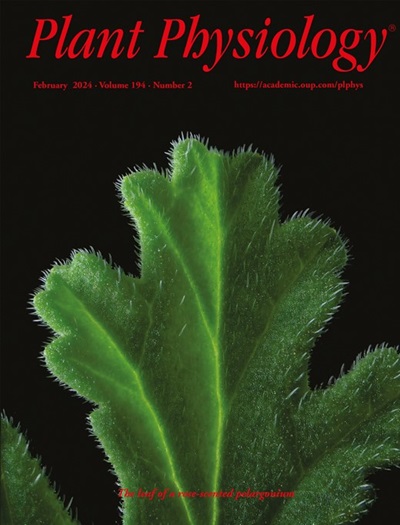五肽重复蛋白PPR767调控水稻植株结构和抗旱性。
IF 6.5
1区 生物学
Q1 PLANT SCIENCES
引用次数: 0
摘要
核编码的RNA结合蛋白(rbp)是真核生物RNA代谢所必需的。五肽重复(Pentatricopeptide repeat, PPR)蛋白是rbp的一个大子集,通过参与细胞器RNA加工对植物发育和繁殖至关重要。在这里,我们发现了一个e型PPR蛋白,PPR767,它在线粒体中起作用。与野生型相比,敲除PPR767导致植株高度降低,茎干变细,叶片变短变窄,从而影响产量性状。PPR767主要参与NADH脱氢酶(nadad)相关的四个位点的RNA编辑,包括nad1-674、nad3-155、nad3-172和nad7-317。PPR767与包括MORF1和MORF8在内的多种细胞器RNA编辑因子(morf)相互作用,表明水稻(Oryza sativa)中的编辑体很复杂。突变体表现出线粒体复合物Ⅰ活性降低和线粒体结构受损。此外,PPR767突变影响了水稻抗旱性和活性氧积累相关基因的表达水平。因此,PPR767通过适当调节线粒体基因的RNA编辑效率,对复杂的Ⅰ活性至关重要,并通过调节水稻的ROS含量影响水稻的抗旱性。我们的发现为ppr实现其功能的机制提供了有价值的见解。本文章由计算机程序翻译,如有差异,请以英文原文为准。
The pentatricopeptide repeat protein PPR767 modulates plant architecture and drought resistance in rice.
The RNA-binding proteins (RBPs) encoded by the nucleus are essential for RNA metabolism in eukaryotes. Pentatricopeptide repeat (PPR) proteins, a large subset of RBPs, are essential for plant development and reproduction by participating in organellar RNA processing. Here, we identified an E-type PPR protein, PPR767, which functions in mitochondria. Knocking out PPR767 resulted in decreased plant height, thinner stems, shorter and narrower blades, and consequently affected yield traits compared to those of the wild-type. PPR767 primarily participated in the RNA editing of four sites related to NADH dehydrogenase (Nad), including nad1-674, nad3-155, nad3-172, and nad7-317. PPR767 interacted with multiple organellar RNA editing factors (MORFs), including MORF1 and MORF8, suggesting that the editosome in rice (Oryza sativa) is complex. The mutants showed decreased mitochondrial complex Ⅰ activity and compromised mitochondrial structure. Furthermore, mutation of PPR767 influenced rice drought tolerance and the expression levels of genes involved in reactive oxygen species (ROS) accumulation. Therefore, PPR767 is essential for complex Ⅰ activity by properly regulating the RNA editing efficiency of mitochondrial genes and affects drought tolerance by modulating ROS content in rice. Our findings provide valuable insights into the mechanisms by which PPRs fulfil their functions.
求助全文
通过发布文献求助,成功后即可免费获取论文全文。
去求助
来源期刊

Plant Physiology
生物-植物科学
CiteScore
12.20
自引率
5.40%
发文量
535
审稿时长
2.3 months
期刊介绍:
Plant Physiology® is a distinguished and highly respected journal with a rich history dating back to its establishment in 1926. It stands as a leading international publication in the field of plant biology, covering a comprehensive range of topics from the molecular and structural aspects of plant life to systems biology and ecophysiology. Recognized as the most highly cited journal in plant sciences, Plant Physiology® is a testament to its commitment to excellence and the dissemination of groundbreaking research.
As the official publication of the American Society of Plant Biologists, Plant Physiology® upholds rigorous peer-review standards, ensuring that the scientific community receives the highest quality research. The journal releases 12 issues annually, providing a steady stream of new findings and insights to its readership.
 求助内容:
求助内容: 应助结果提醒方式:
应助结果提醒方式:


